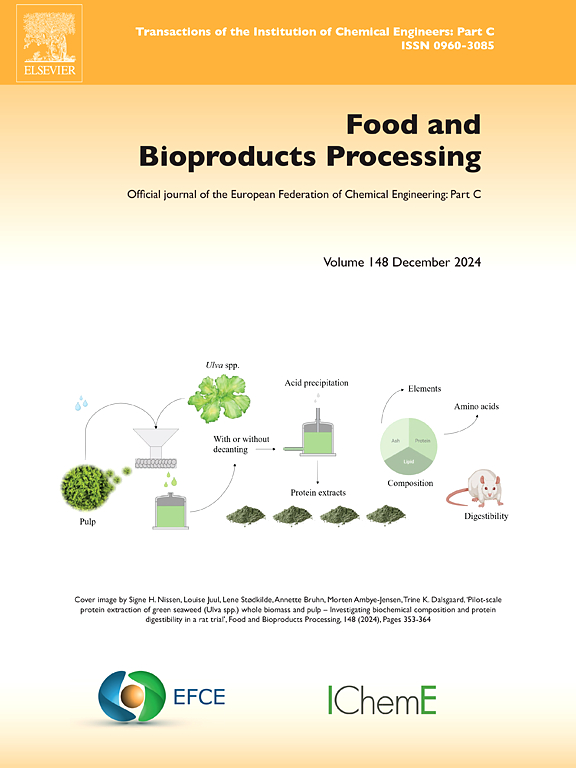Valorization of fruit and vegetable by-products for protein extraction and their functional applications in food and non-food sectors
IF 3.4
2区 农林科学
Q2 BIOTECHNOLOGY & APPLIED MICROBIOLOGY
引用次数: 0
Abstract
The fruit and vegetable processing sector generates substantial quantities of underutilized by-products, creating both economic losses and environmental challenges. Addressing these issues requires innovative strategies for converting these byproducts into valuable resources. This review explores the potential for recovering proteins from by-products of different fruits and vegetables and highlights their uses in the food and non-food sectors. Various extraction techniques, including conventional methods and emerging green extraction techniques, such as pressurized liquid extraction, enzyme-assisted extraction, and pulsed electric extraction, have been evaluated for their effectiveness in isolating proteins while preserving their functional characteristics. The extracted proteins provide substantial nutritional and functional benefits, making them ideal for use in the development of functional foods, fortification, and nutraceuticals. Non-food applications of the extracted proteins, including animal feed, edible films, bioplastics, and biopolymers, are also discussed. To maximize the potential of proteins, future studies should focus on improving sustainable extraction techniques, as well as their regulatory, economic, and safety aspects, and expand the functional applications of these proteins. The purpose of this review is to contribute to healthier and more sustainable food systems by emphasizing the recovery of proteins from fruit and vegetable processing waste streams.
用于蛋白质提取的果蔬副产品的增值及其在食品和非食品部门的功能应用
水果和蔬菜加工部门产生大量未充分利用的副产品,造成经济损失和环境挑战。解决这些问题需要创新战略,将这些副产品转化为宝贵的资源。这篇综述探讨了从不同水果和蔬菜的副产品中回收蛋白质的潜力,并强调了它们在食品和非食品部门的用途。各种提取技术,包括传统方法和新兴的绿色提取技术,如加压液体提取,酶辅助提取和脉冲电提取,已经评估了它们在分离蛋白质的同时保持其功能特征的有效性。提取的蛋白质提供了大量的营养和功能效益,使它们成为开发功能食品、强化和营养保健品的理想选择。所提取的蛋白质的非食品应用,包括动物饲料,可食用薄膜,生物塑料和生物聚合物,也进行了讨论。为了最大限度地发挥蛋白质的潜力,未来的研究应侧重于改进可持续提取技术,以及它们的监管、经济和安全方面,并扩大这些蛋白质的功能应用。本综述的目的是通过强调从水果和蔬菜加工废物流中回收蛋白质,为更健康和更可持续的粮食系统做出贡献。
本文章由计算机程序翻译,如有差异,请以英文原文为准。
求助全文
约1分钟内获得全文
求助全文
来源期刊

Food and Bioproducts Processing
工程技术-工程:化工
CiteScore
9.70
自引率
4.30%
发文量
115
审稿时长
24 days
期刊介绍:
Official Journal of the European Federation of Chemical Engineering:
Part C
FBP aims to be the principal international journal for publication of high quality, original papers in the branches of engineering and science dedicated to the safe processing of biological products. It is the only journal to exploit the synergy between biotechnology, bioprocessing and food engineering.
Papers showing how research results can be used in engineering design, and accounts of experimental or theoretical research work bringing new perspectives to established principles, highlighting unsolved problems or indicating directions for future research, are particularly welcome. Contributions that deal with new developments in equipment or processes and that can be given quantitative expression are encouraged. The journal is especially interested in papers that extend the boundaries of food and bioproducts processing.
The journal has a strong emphasis on the interface between engineering and food or bioproducts. Papers that are not likely to be published are those:
• Primarily concerned with food formulation
• That use experimental design techniques to obtain response surfaces but gain little insight from them
• That are empirical and ignore established mechanistic models, e.g., empirical drying curves
• That are primarily concerned about sensory evaluation and colour
• Concern the extraction, encapsulation and/or antioxidant activity of a specific biological material without providing insight that could be applied to a similar but different material,
• Containing only chemical analyses of biological materials.
 求助内容:
求助内容: 应助结果提醒方式:
应助结果提醒方式:


